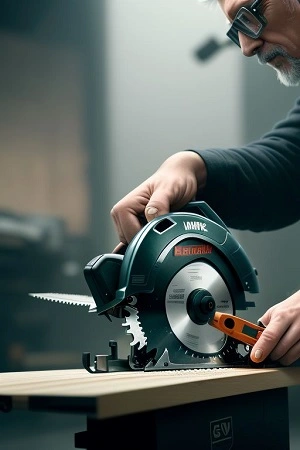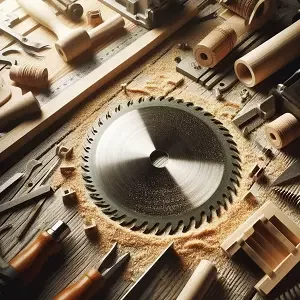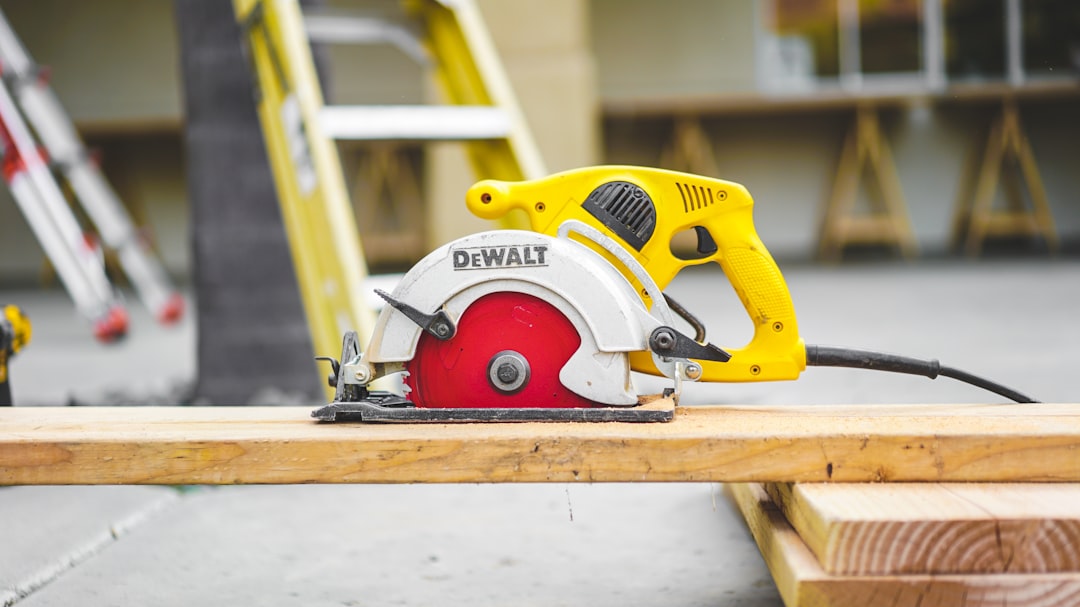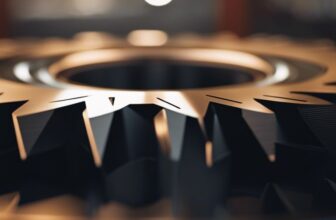Maximizing Your Circular Saw: The Ultimate DIY Guide

Learn how to make the most of your circular saw with this DIY enthusiasts guide, including tips on safety measures, choosing the right blade, adjusting settings, mastering different cuts, maintenance tips, and exploring project ideas.
How to Make the Most of Your Circular Saw: A DIY Enthusiast’s Guide
Circular saws are indispensable tools for DIY projects, offering the precision and efficiency required for cutting plywood, construction lumber, and baseboards. The choice of the right circular saw and blade type significantly impacts the quality and precision of cuts, influencing the outcome of DIY projects. For assistance in selecting the best circular saw for specific project needs and budget, CutMaster.net provides comprehensive reviews, comparisons, and buying guides.
- When choosing a circular saw, it’s important to consider the power source.
Corded circular saws provide consistent power, making them suitable for heavy-duty cutting tasks, while - cordless circular saws offer greater portability and convenience for projects that require mobility and flexibility.
- Additionally, the size of the circular saw is an important factor to consider.
- Compact circular saws are suitable for smaller DIY projects and are easier to handle, while
- full-sized circular saws are ideal for larger and more demanding cutting tasks.
Circular saws are versatile tools that can be used for various DIY projects, from building shelving units to constructing outdoor structures. One of the key considerations when using a circular saw is the selection of the right blade for different materials and cutting applications.
The blade teeth and types are tailored to different DIY project requirements, ensuring smooth and precise cuts for various materials. CutMaster.net offers expert advice on choosing the right circular saw blade for specific DIY projects, facilitating optimal cutting performance and results.
For example, when cutting plywood, a blade with more teeth provides a smoother cut, while a blade with fewer teeth is more suitable for cutting construction lumber. Additionally, specialized blades, such as those designed for cutting metal or plastic, offer versatility for a wider range of DIY projects.
Circular Saw Safety Measures and Precautions
When using a circular saw for DIY projects, prioritizing safety is crucial. Proper eye and ear protection, along with correct handling techniques, are essential safety measures. Additionally, preventing kickback and using push sticks are vital for ensuring safety and minimizing the risk of accidents during cutting.
It’s important to be aware of the potential hazards associated with circular saw operation and take necessary precautions to mitigate risks. For example, wearing a dust mask is important when working with materials that produce fine particles, such as MDF or particleboard, to prevent inhalation of harmful dust.
Furthermore, understanding the proper handling and operation of the saw, including maintaining a firm grip and stable posture, is essential for safe and effective use.

Choosing the Right Circular Saw Blade for Different DIY Projects
The selection of blade teeth and types is tailored to different DIY project requirements, ensuring smooth and precise cuts for various materials. CutMaster.net offers expert advice on choosing the right circular saw blade for specific DIY projects, facilitating optimal cutting performance and results.
In addition to blade selection, the size of the blade also plays a crucial role in determining the cutting capacity of the circular saw. Smaller blades are suitable for lighter cutting tasks and offer increased maneuverability, while larger blades are designed for heavier cutting applications and provide greater cutting depth.
Moreover, considering the material of the blade is important, as carbide-tipped blades offer enhanced durability and longevity compared to standard steel blades, making them ideal for more demanding cutting projects.
Adjusting Bevel, Depth, and Straight Edge Guiding
Achieving precise and accurate cuts in DIY projects requires proper adjustment of the bevel and depth settings. This is essential for ensuring professional-quality results. Utilizing straight edge guiding also enhances cutting accuracy, especially when working on large materials such as plywood and construction lumber.
Furthermore, the incorporation of additional guiding accessories, such as rip fences and miter gauges, can further enhance the precision and versatility of the circular saw for various cutting applications. These accessories provide support and guidance for making straight and angled cuts, contributing to the overall accuracy and quality of the finished project.
Mastering Cross Cuts and Rip Cuts with a Circular Saw
Circular saws are versatile for performing cross cuts and rip cuts, providing flexibility in cutting different types of wood and materials. They are ideal for cutting plywood and construction lumber, making them indispensable for a wide range of DIY projects.
When making cross cuts, using a circular saw with a guide rail system ensures straight and precise cuts, resulting in clean and accurate edges.
Similarly, when performing rip cuts, the use of a rip fence or a straight edge guide helps maintain a consistent cutting width and minimizes the risk of deviations during the cutting process. This level of precision is essential for achieving professional-quality results in DIY woodworking and construction projects.

Making Jigs and Plunge Cuts with Your Circular Saw
Creating jigs enhances cutting precision and allows for the replication of specific cuts, contributing to the consistency and quality of DIY projects.
CutMaster.net offers innovative jig-making ideas and techniques, providing DIY enthusiasts with resources to elevate their cutting precision and project outcomes. In addition to traditional jigs, the use of advanced cutting guides and templates further enhances the versatility and accuracy of plunge cuts with a circular saw.
These accessories enable intricate and complex cutting patterns to be achieved with precision, expanding the creative possibilities for DIY projects and woodworking applications.
Cutting Curves and Plunge Cuts
Circular saws can be effectively used to cut curves and execute plunge cuts, expanding the creative possibilities and design options for DIY projects. Their flexibility and maneuverability make them suitable for intricate and artistic cutting applications, adding unique elements to DIY projects.
When cutting curves, using a specialized curved cutting jig or a flexible curve cutting guide allows for the creation of smooth and precise curved cuts, enabling the incorporation of custom shapes and designs in woodworking projects.
Additionally, for plunge cuts, the use of depth stop accessories and plunge cut saw blades ensures controlled and accurate cutting depths, making it possible to create recesses, slots, and intricate patterns with ease.
Essential Maintenance Tips for Circular Saws
Regular cleaning and maintenance are vital for ensuring optimal performance and longevity of circular saws, contributing to their consistent cutting precision.
CutMaster.net provides comprehensive advice on circular saw maintenance and care, empowering DIY enthusiasts to keep their tools in peak condition for exceptional project results. In addition to regular maintenance, the proper storage and handling of circular saws also play a significant role in preserving their performance and longevity.
Storing the saw in a dry and clean environment, as well as using protective cases or covers when not in use, helps prevent dust accumulation and minimizes the risk of damage to the saw’s components, ensuring it remains in optimal working condition.

Exploring DIY Project Ideas with Your Circular Saw
Circular saws enable a wide variety of DIY project ideas, including crafting pallet Christmas trees, coffee tables, and height-adjustable laptop tables. The creativity and innovation achievable with a circular saw make it a valuable tool for DIY enthusiasts, offering endless project inspiration and possibilities.
In addition to the mentioned projects, circular saws can be utilized for a diverse range of DIY woodworking and construction projects, such as building outdoor furniture, constructing garden planters, and creating custom cabinetry.
Moreover, the versatility of circular saws extends to home improvement projects, including flooring installation, trim work, and renovation tasks, making them indispensable for a wide array of DIY applications.
Conclusion and Call to Action
Circular saws play a pivotal role in achieving professional-quality results in various woodworking and construction applications.
To explore the wide range of circular saw options and resources available, DIY enthusiasts are encouraged to visit CutMaster.net for in-depth circular saw reviews, comparisons, and expert advice.
By leveraging the guidance and insights provided by CutMaster.net, DIY enthusiasts can elevate their woodworking and construction projects, achieving precision, efficiency, and exceptional results with their circular saws.







